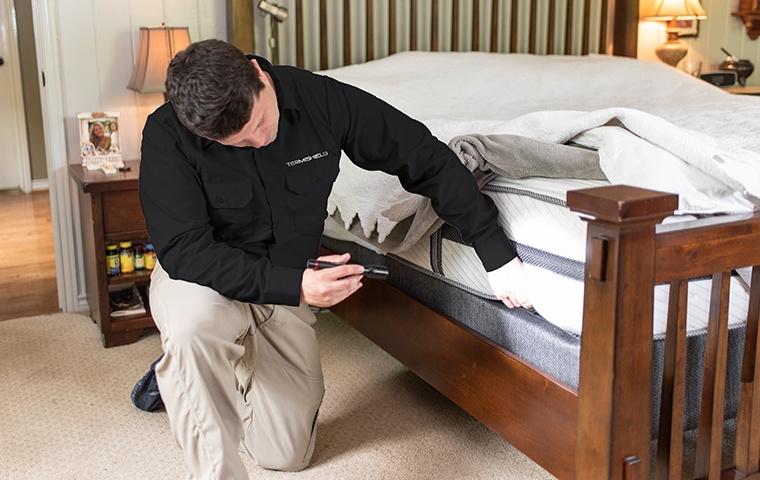Mastering Bed Pest Control: A Detailed Consider Inspection and Treatment Strategies
In the world of parasite monitoring, couple of obstacles are as persistent and unsettling as bed bug invasions. The evasive nature of these small insects, paired with their ability to rapidly multiply and spread, can make removing them a complex job. Grasping bed pest control is not an overwhelming accomplishment. By thoroughly understanding their behavior, carrying out detailed evaluations, identifying vital invasion areas, carrying out tailored therapy techniques, and developing safety nets, it is possible to recover areas from these undesirable trespassers. This in-depth take a look at evaluation and treatment strategies uses a thorough guide to navigate the intricacies of bed insect management, shedding light on effective methods that can assist in dealing with these durable foes.
Comprehending Bed Bug Behavior

Bed insects launch gathering pheromones, which attract others to cluster together in concealing areas, assisting in their reproduction and survival. This actions promotes the spread of problems within a residential property and to neighboring systems. In addition, bed pests have revealed resistance to various chemicals, making removal initiatives much more complicated.

Carrying Out Thorough Assessments
Given the elusive nature of bed insects and their tendency to conceal in unattainable areas, extensive examinations play a crucial role in finding and dealing with infestations properly. Beginning by examining locations where bed insects are understood to hide, such as bed mattress seams, box springtimes, bed frameworks, and headboards.
Use tools like flashlights, multiplying glasses, and hole tools to aid in the inspection process. Seek indicators of bed pest activity, consisting of dark spots (feces), shed skins, and real pests. Keep in mind that not all indications might be visible to the naked eye, so an eager attention to information is critical. It is also suggested to examine surrounding spaces or devices if bed insects are discovered, as problems can rapidly spread (bed bug exterminator seattle topbedbugkillersofseattle). By performing comprehensive examinations regularly, very early detection and efficient therapy of bed bugs can be achieved, lessening the danger of an extensive problem.
Identifying Key Invasion Areas
To efficiently deal with bed pest problems, it is critical to pinpoint crucial areas where these pests are likely to congregate and prosper. Bed bugs are nocturnal bugs that conceal in fractures and holes throughout the day, coming out at evening to feed on blood. In addition, upholstered furnishings such as couches and chairs, as well as drapes and rug sides, are prime hiding spots for bed bugs.
Bed pests can additionally infest electric outlets, picture frames, and also behind loosened wallpaper. Inspecting these essential locations completely is crucial for effective bed pest control. bed bug exterminator seattle topbedbugkillersofseattle. Early discovery and therapy in these invasion hotspots can stop the spread of bed insects to other parts of the building and decrease the intensity of the infestation
Applying Efficient Therapy Methods
Upon determining vital problem areas, the next important action in combating bed bugs is applying effective treatment techniques. Warm therapy, which entails raising the ravaged area to temperatures lethal to bed bugs, is very effective in eliminating bed pests at all life phases, consisting of eggs.
Insecticide applications are typically required to supplement non-chemical methods, with specialists making use of a variety of products such as desiccants, insect growth regulatory authorities, and residual pesticides to target bed insects directly. Proper application strategies, focusing on areas where bed insects conceal or take a trip, are essential for successful treatment. bed bug exterminator seattle topbedbugkillersofseattle.

Preventing Future Bed Insect Events
To prevent the renewal of bed bugs, it is necessary to inform people on the indications of an infestation and the significance of very early detection. Furthermore, implementing proactive steps like utilizing bed bug-proof cushion coverings, securing cracks and gaps, and decreasing mess can make it harder for bed insects to establish themselves in a home.
Additionally, exercising good hygiene and cleanliness can also hinder bed bugs from infesting an area. Laundering bedding and apparel regularly in hot water and vacuuming often can remove possible hiding areas for bed insects. When traveling, checking bed bug exterminator seattle topbedbugkillersofseattle resort spaces for signs of bed bugs and maintaining luggage elevated off the flooring can avoid bringing these bugs home. By being watchful and taking preventive activities, individuals can considerably minimize the probability of experiencing future bed pest cases.
Conclusion
In conclusion, mastering bed pest control requires a deep understanding of their habits, extensive evaluations, recognition of essential invasion locations, efficient treatment strategies, and avoidance steps. By adhering to these actions faithfully, individuals can efficiently take care of and remove bed pest infestations in their spaces. It is vital to remain alert and proactive to make sure that bed bugs do not become a repeating problem.